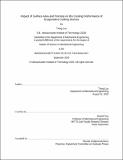Impact of surface area and porosity on the cooling performance of evaporative cooling devices
Author(s)
Luu, Trang(Trang N.)
Download1227044322-MIT.pdf (3.607Mb)
Other Contributors
Massachusetts Institute of Technology. Department of Mechanical Engineering.
Advisor
Daniel Frey.
Terms of use
Metadata
Show full item recordAbstract
Evaporative cooling devices are low-cost, low-energy solutions for post-harvest storage of fruits and vegetables on farmlands. Surface area and porosity are two design parameters that affect the cooling devices' evaporation rate and cooling performance. Both design parameters lack prior systematic testing that methodically varies levels of surface area and material porosity to understand their effects on these devices' cooling performance (e.g. maximum temperature drop, duration of high internal relative humidity, cooling efficiency and total cooling). For fruits and vegetables, storage environments with low temperature and high humidity are critical to reduce deterioration. In this thesis, ridges were cut into the outer wall of pot-in-pot evaporative cooling devices at four different interridge distances to vary total available surface area. Sawdust was added to clay in different ratios to create devices with varying porosity. A new performance metric of total cooling is also introduced to account for the maximum temperature drop and the total duration of evaporative cooling. The surface area experiments reveal that adding corrugations on the surface introduces competing effects between increased surface area for water evaporation and decreased vapor concentration gradient inside of the corrugations' troughs; consequently, among the devices with corrugations, the amount of total surface area does not always correlate with cooling performance. Between the devices with some surface corrugation and the device without corrugation, the devices with corrugation do consistently achieve greater temperature drops. However, the devices with corrugation are unable to maintain temperature drops and high levels of internal relative humidity for as long as the device without corrugation. The porosity experiments conclude that the greater the porosity in the device's outer vessel, the greater the maximum temperature drop. This is due to the reduced transport resistance during water and moisture movement to the device's surface. Higher percentages of porosity lead to faster evaporation rates which deplete the amount of water inside the devices quicker and explain why the temperature drops and internal relative humidity of the more porous devices do not last as long as the temperature drops and internal relative humidity of the less porous devices. This thesis investigates two design parameters of cooling devices and shows that increasing surface area and porosity increases maximum temperature drops but decreases both the duration of temperature drops and high internal relative humidity. Between the two design parameters, increasing porosity is the more practical and less burdensome solution to improve the overall performance of evaporative cooling devices for low-resource communities.
Description
Thesis: S.M., Massachusetts Institute of Technology, Department of Mechanical Engineering, September, 2020 Cataloged from student-submitted PDF version of thesis. Includes bibliographical references (pages 110-111).
Date issued
2020Department
Massachusetts Institute of Technology. Department of Mechanical EngineeringPublisher
Massachusetts Institute of Technology
Keywords
Mechanical Engineering.